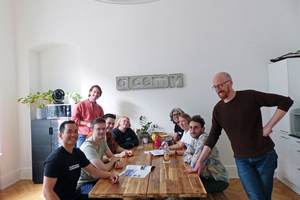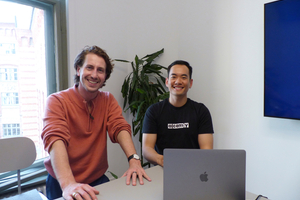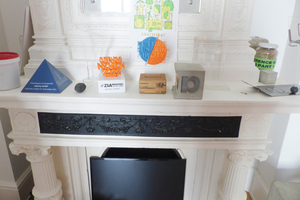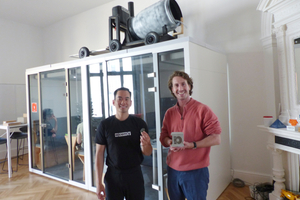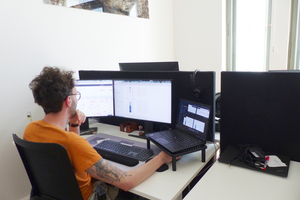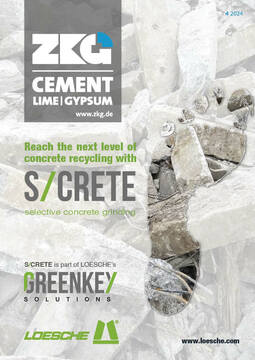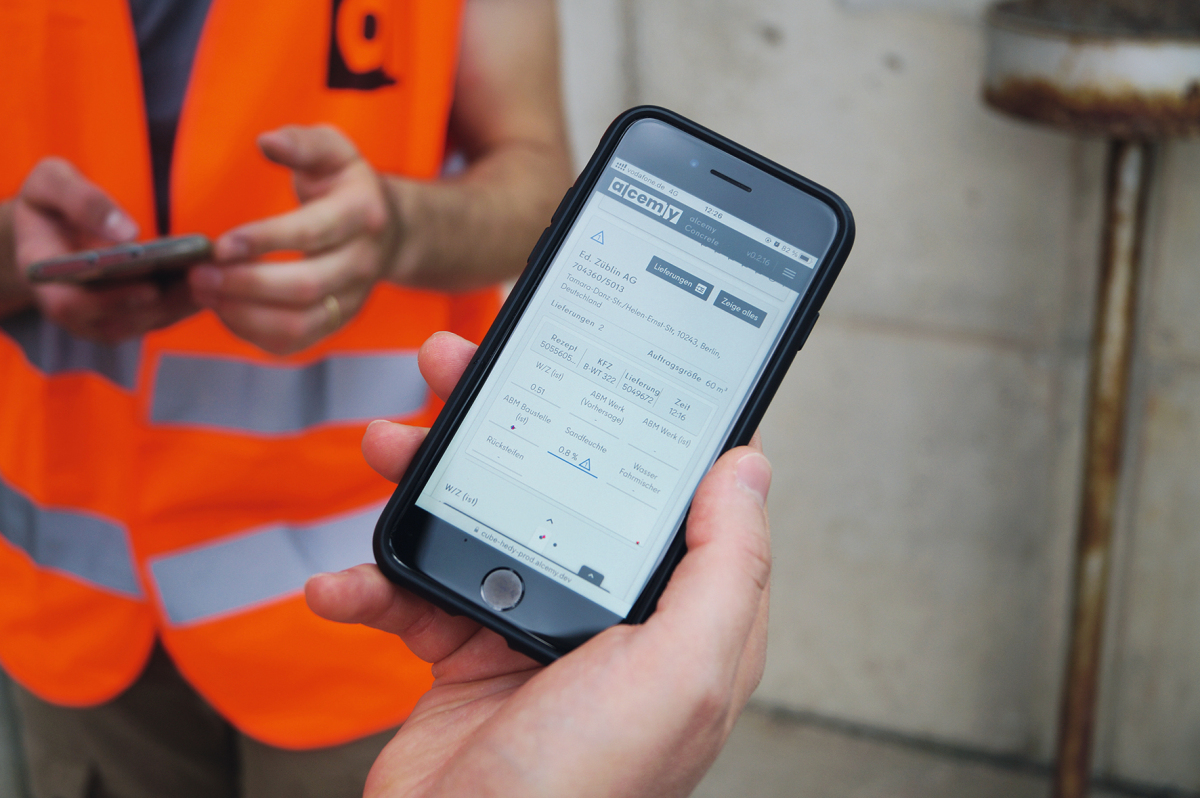No decarbonization without digitalization: a visit to alcemy
Offices in 100-year-old buildings: not an uncommon sight in Berlin‘s start-up culture - but perhaps a rather unusual environment for companies associated with the cement and concrete industry as well as Artificial intelligence. But this is exactly where alcemy is at home, at Rosenthaler Straße 51. The company‘s clear vision is to use the right technology to enable cement and concrete manufacturers to successfully take the path to climate neutrality. In 2018, Leopold Spenner and Dr. Robert Meyer founded alcemy with the conviction that a reduction in CO2 can and must also go hand in hand with a reduction in production costs. This is where technology met tradition: while Meyer, who holds a doctorate in neuroinformatics, brought in expertise in the fields of AI and data science, Spenner comes from a long line of cement producers and has spent much of his free time at his parents‘ cement plant since childhood. Where is the company today? And what are the most important stages on the way to decarbonizing and digitalizing the cement industry? Hoang Anh Nguyen, Head of Communications at alcemy, and Oliver Kanders, Vice President, invited the ZKG to the capital city office and answered questions in what turned out to be a wide-ranging and exciting interview.
Kanders: I’m Oliver Kanders and I’ve been with alcemy for 18 months now. I originally studied economics and then worked for four years at large media companies, for example at Handelsblatt in Düsseldorf and for Bertelsmann in Gütersloh. I worked for the management boards there, then came to Berlin – to the world of start-ups – and have been working in this environment for ten years now. Among other things, I helped set up a Big Data company in the advertising sector. Nine years ago, you could only do big data in the world of advertising and finance - that has changed today. The company still exists and is doing well with over 200 colleagues today. During Covid, however, I thought: This could all go on so nicely now. But what will actually happen when I look back on my career in 30 years? Is this really my last professional mission in life? And my heart said no. And then I realized that you can now also do interesting things with big data in concrete and cement. And now I‘m here, managing the customer side.
Nguyen: My name is Hoang Anh Nguyen and I have been with alcemy for two and a half years now. I am responsible for communication and partnership programs with construction and real estate companies. I also originally come from this sector, having previously studied Public Economics and Politics and worked in lobbying for a construction and real estate association. At alcemy, I am working on how we can make our brand and products better known and how we can accelerate our mission of decarbonizing the concrete value chain at the same time. We realized early on that this would require the involvement of the real estate and construction industry - In other words, those who buy the concrete and use it on their construction sites. In my role, I work with players from the real estate industry to work out exactly how the use of sustainable concrete can be successful.
Kanders: The issues of quality assurance and decarbonization in cement and concrete cannot be viewed in isolation from one another. In 2018, for example, there was a research project by Spenner and the VDZ with cements that contained up to 50% limestone powder with enormously reduced water/cement ratios. This research was important because the aim was to see how the proportion of clinker could be reduced using widely available substitutes. The result was clear: in a labratory context these cements were possible. The problem, however, was that cement and ready-mix concrete production are not happening under such conditions. The results could therefore not be transferred into practice. Leopold Spenner and we, the alcemy team set out to do just that and developed a predictive quality software with products for cement and ready-mix concrete that is monitoring and supporting manufacturers to precisely produce such cements and concretes.
This may sound so banal, but measurability and good quality assurance really are crucial and at the heart of cement and ready-mix concrete production, with huge quantities on a daily basis.In principle, production today is carried out with an incredibly high degree of reservation. If you don‘t know exactly what quality you are producing today, then you have to produce every day as if it were a really bad day because you don‘t know the exact result. And we provide transparency by enabling every manufacturer to react in real time.
Nguyen: Yes, exactly. First of all, from a purely logical point of view, the product works independently of the issue of decarbonization. Better quality in cement and concrete production is always important, as this is a key factor for our customers in differentiating themselves from the competition. But where the software‘s greatest potential will be unleashed, as Oliver has already said, is in the development and launch of new types of cement. Our customer Spenner, for example, has received a general building authority approval for a particularly clinker efficient cement with a clinker content of only 30% (known as CEM X) at two German cement plants.
Kanders: A brief addition to this. Of course, economic efficiency also plays an important role. Every solution that is implemented must ultimately be economically viable for the company. There are currently a large number of approaches in the context of decarbonization that significantly increase the cost of production. There is CCU/CCS, for example - without question, we will need these technologies. Ultimately, however, hundred of millions of investments will be needed. The first step must therefore be to focus on clinker efficiency, as such cements can be economically attractive. This is precisely where we at alcemy come in and firmly believe that this can be very interesting for our customers.
Nguyen: Since I started, we have more than doubled in size - at the moment 55 people are working at alcemy. That‘s really great and motivating to see. Our team can be roughly divided into three parts. Firstly, there are the machine learning and software experts. We have great colleagues who have a doctorate in machine learning and data science or have already worked in large software companies. They know how to build modern software products. Another third are our cement and industry experts, who come from various areas of cement and building materials research or geosciences, but in particular also from the field - colleagues who have worked for years as concrete technologists at manufacturers, for example, and know the business extremely well. The last third are people who know how to build a sustainable organization, who come from successful companies that have scaled quickly.
I believe that these three areas are essential. It is often the case that companies have an enormous amount of industry expertise, but are unable to build software. Or software companies that don‘t know how the industry works and don‘t speak the language of their customers. At alcemy, however, we bring all of this together.
Nguyen: Everyone is talking about decarbonization. The ETS has been around since 2005, and the issue hangs over the industry like a sword of Damocles. Of course, there is massive pressure on manufacturers to produce in a truly sustainable way, for example with CCS/CCU technology or new cements, which are also described in the VDZ roadmap. In the past, the topic played a subordinate role. In recent years, the demand for sustainable concretes has increased significantly, but clients and construction companies still have difficulties defining and classifying sustainable concretes correctly. The public sector, for example, is still tendering based on the criterion of the lowest price. Currently there is the fundamental problem that sustainable concretes are naturally more expensive to produce and therefore the demand side, both public and private, is not prepared to pay for that.
This is why developments such as the CO₂ shadow price will help in the future. The aim is, for example, to include not only monetary profitability but also sustainability as an additional criterion when awarding contracts. This could be done by calculating an additional factor for how expensive everything has to be in terms of CO₂. The Federal Environment Agency, for example, sets € 237 for each t of CO₂ that is emitted, namely the actual cost of the externalized consequences of CO₂ for our planet. With these new conditions, the production of the launch of new clinker-efficient cements and concretes would then be profitable.
Kanders: Three challenges starting with a c come to mind, the first of which is “countability” or measurability. If I have no way of measuring or counting how everything is working at the moment, then I have to focus on that first, because measurability is essential for everything that is happening. The second aspect is „courage“. You need to move forward and do things differently when you have perhaps done many things in a similar way over the last 25 years. In this respect, I think we at alcemy are a kind of accelerator, because we look at a common database together with the manufacturers and are able to say: „We‘ve already done the same thing at five other cement plants, and it worked really well. Take the leap of faith!“ The third challenge is „collaboration“. And this is about the fact that we have a solution for both the cement plant and the concrete plant. In my opinion, this is very important for the industry: In the past, it was essentially the case that a cement manufacturer made CEM I and the people in the concrete plant always got the same input. It was always just CEM I, it was bulletproof, everything ran along fixed lines.
What we are now creating is an objective basis so that these two sides can talk to each other better, because this means that we can work on the basis of data and facts. We can determine how the cement actually behaves in the concrete plant. In this way, we are creating the basis for the two parties to talk to each other more. That is a very big need that we see in the market.
Kanders: We first look at the customer and basically understand the challenge that the cement plant faces. We can then assess whether we can help or not, but it usually works, especially when it comes to the quality and stability of cement and the introduction of new cements. This often raises the question for cement manufacturers as to whether they can dare to do this. Can we achieve the right quality if we now take out significantly more clinker? Do the challenges faced by this cement manufacturer match the solution we have on hand? Does the cement plant have the technical requirements to work successfully with us? This involves the laboratory equipment, grain size distribution, XRF and XRD – X-ray diffraction and X-ray fluorescence analysis. If a cement plant has these three devices and is already using them, then there is enough data for us to successfully feed our algorithms. If it only has two of these devices, then you have to take another look at how good they already are. They may also have to buy the third one so that they have a good database. These are the conditions that we check first. Then we make a business case with our customers. We calculate how much potential there is if we manage to achieve their goals. These targets can be a reduction in clinker factors or a reduction in energy consumption at the cement mills. This means that we can grind coarser where otherwise the grinding would be too fine. So we have different levers that we evaluate. If the cement manufacturer is then satisfied with the solution offered, it takes around three months before we can get started. Not much actually has to happen in that time; the cement manufacturer essentially has to create a data export. This is coordinated once between the teams, which takes around one to two months. As soon as the data export is final, it is fed into our system so that the algorithms can be trained with it. The algorithms are always adapted for the individual cement plant because all cement works are very different. This takes about a month, which adds up to a total of three months. We then move on to day-to-day operations, where we work with the quality and production managers to improve the fineness of the cement.
Nguyen: Basically, we often speak at various events, including those organized by the ECRA and VDZ. With regard to the concrete side, we attended six regional conferences at the German Construction Technology Association to discuss in detail how the pouring of sustainable concrete and quality monitoring up to the construction site works. Oliver recently took part in a CemTech webinar on the topic of digitalization. In addition, we have offered webinars in the past where we specifically address a somewhat broader audience, namely project developers, construction companies and cement and concrete customers. In the coming months, we are also planning to hold another event specifically on clinker-efficient cements and predictive quality control. At such events, we always try to pass on the successes of our customers, which they also want to share, to others, but also to talk about advancing the topic of decarbonization from a software perspective in general, because this is ultimately what drives us all.
Sustainability and decarbonization are ultimately challenges for the entire concrete value chain; it is not just the cement industry that is to blame as the sole polluter and therefore has an obligation to decarbonize, but everyone else in the chain. And that’s why it is so important to talk to those involved in construction, planners and ready-mix concrete manufacturers.
Kanders: Rohrdorfer is a good example which recently has been mentioned in a video by the Federal Ministry for Economic Affairs and Climate Protection: The company is one of our customers that globally is working the hardest on decarbonization. Rohrdorfer has reduced the clinker factor by 7% within 2 years. That‘s not all our work, we always do it together with customers, but the company is pushing particularly hard. We think that‘s great, of course. Opterra, a CRH company, for example, is another customer that has significant savings of several hundred thousands per year by using our technology. This is due to the fact that less energy is consumed, as well as the fact that clinker is constantly being substituted and further progress is being made. Another example from an American customer: In the USA, the market is at the 100% capacity limit, which is why 20% of all cement in America is imported, for example from Turkey or Indonesia, i.e. from far away places. It‘s very much a question of being able to grind coarser in places where you would otherwise grind too finely when you see that the cement is firm enough, because then of course you get more through the mill. The throughput of the mill increases, which means that the company can produce more cement, so significantly less cement has to be imported. And of course it is much more profitable for the manufacturer. These three examples perhaps cover quite well the three different dimensions where we apply the leverage in the cement plant. Many of our customers are currently introducing new cements, the biggest example being the introduction of CEM X.
Nguyen: The VDZ also recently pointed out that there is a record number of new approvals in the industry. The industry is aware that the clinker factor has to be reduced further and further and I believe that the VDZ has set this limit at 63% of the clinker factor by 2030. Experts believe that it can go down even further, e.g. around 0.5. This is of course the approach that can be seen as a huge lever to sucessfully achieve the decarbonizazion. And one starting point for achieving this clinker efficiency is CEM X, for which several manufacturers are currently working on it’s approval and have already applied to the German Institute for Building Technology. Our customer Spenner was the fastest in this sense, because they have been carrying out extensive trials for multi-composite cements since 2018 and testing how the perfect composition is possible on a laboratory scale, and then working with alcemy to put the technology into practice and get their product “naturecem 65 PKH” (CEM X) approved. I believe that CEM X is really setting new standards as an important project for our customers. You can see from the fact that other customers are following this example that there is motivation and courage in many places to embark on this path.
Nguyen: In terms of content, we were not directly involved because we are not a member of the VDZ. Only cement manufacturers can be members in the VDZ. Nevertheless, there was always a close exchange with Dr Schneider, who helped us a lot with product development, especially in the beginning, and contributed industry expertise in our early years. Dr Schneider is familiar with alcemy’s approach and also believes in CEM X and clinker-efficient cements. However, in the current decarbonization roadmap, the topic has been included in a relatively small way. The focus is still very much on CCU/CCS. I believe that the roadmap will probably be revised in the next few years and will be adapted again so that there are new types of cements that go much further.
Kanders: The big issue is clinker efficiency. To achieve this goal, you have to pull several levers at the same time. If I don‘t have any laboratory equipment, then I can‘t collect any data. There are different aspects that are absolutely important. CEM X with an average clinker content of only 30% requires separate grinding, as both clinker and granulated blast furnace slag have to be very finely ground. However, the limestone has to be coarsely ground because otherwise I have a too high water demand. And if the water demand is higher, I won’t get the strength development right. These are all issues that need to be looked at.
It’s actually always a puzzle and we at alcemy see ourselves as a toolbox because we are a multi-purpose technology. Because we improve the production stability and efficiency, we can be used for various levers. However, it doesn‘t just work through our approach alone. If the manufacturer wants to produce CEM X but doesn‘t yet have a separate grinding system, they won‘t be able to get the cement to the construction site in such a way that it works well, even with our help. And so these issues are simply interlinked to a certain extent.
Kanders: We are now active worldwide in the cement sector. In total, we are active in ten markets ranging from DACH to Ireland, Portugal, Spain, Poland, the Czech Republic and Turkey to the US. We have already proven that we can work very well with cement manufacturers across continents and time zones. For example, we have a plant in the USA since last year, which is working fantastically. The cement plant uses a “closed loop”, i.e. automatic feed into the mill according to our fineness recommendations. The manufacturer sends us the data, we calculate the predictions and give the fineness recommendations, which are automatically sent to the mill. The mill then adjusts automatically, and we have achieved an improvement in the standard deviations of over 30%. This is also around our average, between 20 and 40%. Once a week we talk to the people involved about the results and data.
Kanders: Our biggest focus is on Europe. Simply because this is where we see the strongest connection with our decarbonization mission, which we take very seriously as a company. In principle, however, we are focused on the whole world, we just believe that there will be a natural phase sequence. Europe is now more or less leading the way, including with regulation, which I think also describes what will happen in the next few years. So basically, we see a high level of interest in our technology all over the world. But we also see the greatest pressure for decarbonization here in Europe. Our goal here is to get as many cement manufacturers on board as possible right now. Then, from 2027, when the CO2 certificate allowances fall, have the opportunity to save costs and decarbonize very quickly and reliably with our technology.
Nguyen: We are already a medium-sized company - even though we’ve only been around for five years: The number of employees, the expertise that Oliver mentioned earlier and also our standing in the industry speak for this in my opinion. We didn‘t come into the industry from a purely technological point of view in order to act as a “disruptor” but have always worked in partnership with the cement and concrete manufacturers. And that’s why they now see us as equals, so to speak, as a technology provider, specifically for cement plants. Accordingly, it has certainly been one of our goals to no longer operate in this pure start-up context. However, that in itself is just a matter of definition.
Kanders: We now operate 1/3 of all German cement plants with alcemy. That‘s why I believe that our technology has really arrived in the industry. Our aim is to replicate this in other countries and, of course, to help even more cement plants in Germany. In principle, the idea - and we see this with our customers - is that they want this kind of technology for their entire group. Our work is based on real problems in the industry for which we can identify solutions. That’s why we offer a systemic solution. And the aim is that just as every cement plant has a mill to grind, cement plants will have this technology from now on.

